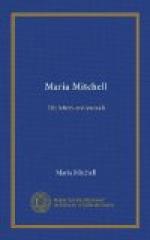There were always plenty of books, and besides those in the house there was the Atheneum Library, which, although not a free library, was very inexpensive to the shareholders.
There was another very striking difference between that epoch and the present. The children of that day were taught to value a book and to take excellent care of it; as an instance it may be mentioned that one copy of Colburn’s “Algebra” was used by eight children in the Mitchell family, one after the other. The eldest daughter’s name was written on the inside of the cover; seven more names followed in the order of their ages, as the book descended.
With regard to their reading, the mother examined every book that came into the house. Of course there were not so many books published then as now, and the same books were read over and over. Miss Edgeworth’s stories became part of their very lives, and Young’s “Night Thoughts,” and the poems of Cowper and Bloomfield were conspicuous objects on the bookshelves of most houses in those days. Mr. Mitchell was very apt, while observing the heavens in the evening, to quote from one or the other of these poets, or from the Bible. “An undevout astronomer is mad” was one of his favorite quotations.
Among the poems which Maria learned in her childhood, and which was repeatedly upon her lips all through her life, was, “The spacious firmament on high.” In her latter years if she had a sudden fright which threatened to take away her senses she would test her mental condition by repeating that poem; it is needless to say that she always remembered it, and her nerves instantly relapsed into their natural condition.
The lives of Maria Mitchell and her numerous brothers and sisters were passed in simplicity and with an entire absence of anything exciting or abnormal.
The education of their children is enjoined upon the parents by the “Discipline,” and in those days at least the parents did not give up all the responsibility in that line to the teachers. In Maria Mitchell’s childhood the children of a family sat around the table in the evenings and studied their lessons for the next day,—the parents or the older children assisting the younger if the lessons were too difficult. The children attended school five days in the week,—six hours in the day,—and their only vacation was four weeks in the summer, generally in August.
The idea that children over-studied and injured their health was never promulgated in that family, nor indeed in that community; it seems to be a notion of the present half-century.
Maria’s first teacher was a lady for whom she always felt the warmest affection, and in her diary, written in her later years, occurs this allusion to her:
“I count in my life, outside of family relatives, three aids given me on my journey; they are prominent to me: the woman who first made the study-book charming; the man who sent me the first hundred dollars I ever saw, to buy books with; and another noble woman, through whose efforts I became the owner of a telescope; and of these, the first was the greatest.”




